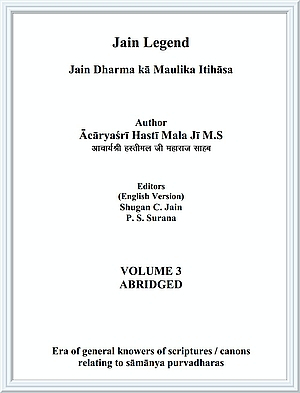(V.N. 867 1834)
Mayūra Śarman was the founder and first king of Kadamba dynasty. He ruled from 340 to 370 AD. The last King of this dynasty was King Kāma Deva who ruled from 1238 to 1307 AD.
Rāṣṭrakūṭa (Raṭṭa) dynasty
(V.N. 952-1499)
Kings, queens, queen mothers, princes, chiefs of armed forces, ministers and their subjects all contributed significantly for the all-round popularity and practice of Jainism during their times.
King Akāla Varṣa of Rāṣṭrakūṭa dynasty was ruling certain provinces during the reign of Gaṃga dynasty rulers Avīnita (425-478AD). One of his ministers, Varaṇeguppe donated one village to Bhaṭṭāraka Candra Nandi.
At the request of Gaṃga dynasty minister Cākirāja, King Govinda-III of Rāṣṭrakūṭa dynasty donated village Jāla Maṃgala to Ācārya Arka Kīrti of Yāpanīya congregation (Punnagavrakṣamūlagaṇa of Nandi congregation). Ācārya Arka Kīrti had earlier cured one of his advisers, Vibhavāditya, from the distressing effects of Saturn. During the period of his rule, his elder brother Kamba ruled Gaṃga Pradeśa. When Kamba in 807AD was halting in the town of Talawana, at the request of his son he donated a village to Jainācārya Vardhmāna.
The eleventh ruler of Rāṣṭrakūṭa dynasty, Amogha Varṣa was a firm believer and practitioner of Jainism. He used to consider himself blessed by paying obeisance to his guru Senācārya. King Amogha was also a prominent poet and scholar also besides being a popular King. He composed two prominent texts known as 'Ratna Mālikā' and 'Kavirāja Margalaṃkāra'. In Ratna Mālikā he has described his Kingship and renunciation of the throne later on. During his rule, Jainism was observed throughout south as the most popular religion.
Nineteenth King Kṛṣṇa Kannara of Rāṣṭrakūṭa dynasty ruled from 945956 AD. During his time, many important Jainācāryas, such as Soma Deva, Puṣpa Danta, and Indra Nandi etc were preaching Jainism. During his rule, King Vallāla renounced Jainism and adopted Śaiva religion and started inflicting cruelty on Jain monks and followers. During the prime of his rule, most probably King Kṛṣṇa sent a huge army under the leadership of his brother in law Māra Siṃha (24th king of Gaṃga dynasty) to attack Vallāla. Gaṃga prince Māra Siṃha defeated Vallāla and protected Jainism and its followers like King Bhikkhgaṇurāya Khāravela protected Jainism by attacking and defeating Puṣya Mitra Śuṃga.
In 972AD, the 20th ruler of Rāṣṭrakūṭa dynasty, Karka (or Amogha Varṣa-II) was defeated by King Harṣa Siyāla of Dhārā. With this defeat and loss of their capital Mānyakheṭa, the Rāṣṭrakūṭa dynasty, which was the profound propagator and protector of Jainism, became almost extinct.
During the long rule of Rāṣṭrakūṭa dynasty, Jainism prospered and became popular in exemplary manner amongst masses and kept on growing by leaps and bounds. End of Rāṣṭrakūṭa dynasty rule also brought the gradual decay and fall of Jainism in southern India.
Golden era of composing venerable descriptive literature of Jains
Not only Jainism and Jain congregation, but even the Jain literature also saw incredible progress during the rule of Rāṣṭrakūta dynasty. Aṣṭaṣatī by Akalaṃka, Aṣṭasahastrī by Vidyā Nandi, Parikṣāmukha Sūtra by Māṇikya Nandi, and its commentary Prameya Kamala Mārtaṇḍa by Prabhā Candra, Ṣaṭkhaṇḍāgama by Vīra Sena and Jaya Dhavalā commentary on Kaṣāya Pāhuḍa by Jaya Sena, Ādi Purāṇa by Jina Sena, Guṇa Bhadra and Vīra Sena, Pārśyvābhvudśya by Jina Sena and Uttara Purāṇa and Ātmānuśāsana by Guṇa Bhadra, Kavirāja Mārga and Praśnottara Mālikā by King Amogha Varṣa, Yaśodhar kāvya and Mahā Purāṇa by Puṣpa Danta in Apabhraṃśa, Yaśastilaka Campu by Soma Deva, Kṣatra Cuṇāmaṇi and poetic (gadya) composition Cintāmaṇi by Vādībha Siṃha Udaya Deva, popular stotra called Jwālāmālinī by Indra Nandi etc which are considered as the jewels of Jain literature were all written and composed during this golden era of the rule of Rāṣṭrakūṭa dynasty. Hence it will not be out of place to call this era as the golden era of Jain literature also.
 Acharya Hasti Mala
Acharya Hasti Mala
